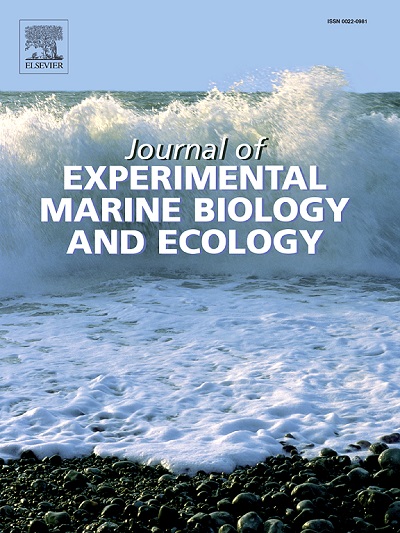We are where we eat! The food selectivity of Copepoda Harpacticoida species on mangrove benthic diatoms and cyanobacteria influences their spatial distribution at a microscale level
IF 1.8
3区 生物学
Q3 ECOLOGY
Journal of Experimental Marine Biology and Ecology
Pub Date : 2025-03-01
DOI:10.1016/j.jembe.2025.152094
引用次数: 0
Abstract
Harpacticoida participate in important benthic processes but their specific interactions with other primary producers are still unknown. This study investigated Copepoda Harpacticoida's selectivity of diatoms and cyanobacteria and whether their microscale distribution is influenced by diatoms and cyanobacteria distribution. We conducted a laboratory controlled experiment, where diatoms and cyanobacteria and four Harpacticoid species (Cletocamptus cf. deitersi, Mesochra sp. Robertsonia mourei and Metis holothuriae) were isolated and cultivated from water and sediment samples collected in the midlittoral zone of the Santa Cruz Canal in Pernambuco, Northeast Brazil. The grazing experiment lasted 24 h. Concurrently, sediment samples were collected with 25 contiguous syringes (1.3cm2) at one centimeter depth to verify the microspatial relation in situ. We characterized the site through the levels of chlorophyll-a, phaeopigments, silt and clay percentage, organic matter percentage and salinity. We found that the species of Copepoda Harpacticoida from a mangrove area fed selectively on different diatoms and cyanobacteria species. Furthermore, our results also indicated that there was a very low overlap in the use of diatoms and cyanobacteria by these Harpacticoida species and that the size of diatoms and cyanobacteria seemed to partially influence their selectivity. For the set of nine diatoms for which there was strong or very strong evidence that the presence of harpacticoid animals decreased their densities due to herbivore-prey interactions, seven were grazed upon by a single harpacticoid species. Our field observational study demonstrates that the aggregated spatial pattern of diatom and cyanobacteria species explains, to a large extent, the spatial distribution of Copepoda Harpacticoida species in the estuarine mud flat. For all tested species, at least one of the diatoms and cyanobacteria selected as food in the laboratory was a significant predictor of harpacticoid species spatial distribution, showing the importance of species-specific relationships.

吃什么就是什么!藻藻桡足类对红树林底栖硅藻和蓝藻的食物选择在微观尺度上影响其空间分布
Harpacticoida参与了重要的底栖生物过程,但它们与其他初级生产者的具体相互作用尚不清楚。本研究考察了桡足藻对硅藻和蓝藻的选择性,以及它们的微尺度分布是否受到硅藻和蓝藻分布的影响。我们进行了一项实验室对照实验,从巴西东北部伯南布哥州圣克鲁斯运河中沿海地区收集的水和沉积物样本中分离培养硅藻和蓝藻以及四种Harpacticoid物种(Cletocamptus cf. deitersi, Mesochra sp. Robertsonia mourei和Metis holothuriae)。放牧实验持续24 h。同时,在1 cm深度用25个连续注射器(1.3 3cm2)采集沉积物样品,验证原位微空间关系。我们通过叶绿素-a、色素、淤泥和粘土百分比、有机质百分比和盐度水平来表征该遗址。我们发现来自红树林地区的桡足类Harpacticoida有选择性地以不同的硅藻和蓝藻为食。此外,我们的研究结果还表明,这些Harpacticoida物种在使用硅藻和蓝藻方面存在非常低的重叠,硅藻和蓝藻的大小似乎部分影响了它们的选择性。有强烈或非常强烈的证据表明,由于草食-猎物的相互作用,竖琴类动物的存在降低了它们的密度,对于这9种硅藻来说,7种硅藻被单一的竖琴类动物吃掉了。野外观测结果表明,硅藻和蓝藻物种聚集的空间格局在很大程度上解释了河口泥滩桡足类物种的空间分布。对于所有被测试的物种,至少有一种硅藻和蓝藻被选为实验室的食物,这是一个重要的预测harpacticoid物种空间分布的指标,显示了物种特异性关系的重要性。
本文章由计算机程序翻译,如有差异,请以英文原文为准。
求助全文
约1分钟内获得全文
求助全文
来源期刊
CiteScore
4.30
自引率
0.00%
发文量
98
审稿时长
14 weeks
期刊介绍:
The Journal of Experimental Marine Biology and Ecology provides a forum for experimental ecological research on marine organisms in relation to their environment. Topic areas include studies that focus on biochemistry, physiology, behavior, genetics, and ecological theory. The main emphasis of the Journal lies in hypothesis driven experimental work, both from the laboratory and the field. Natural experiments or descriptive studies that elucidate fundamental ecological processes are welcome. Submissions should have a broad ecological framework beyond the specific study organism or geographic region.
Short communications that highlight emerging issues and exciting discoveries within five printed pages will receive a rapid turnaround. Papers describing important new analytical, computational, experimental and theoretical techniques and methods are encouraged and will be highlighted as Methodological Advances. We welcome proposals for Review Papers synthesizing a specific field within marine ecology. Finally, the journal aims to publish Special Issues at regular intervals synthesizing a particular field of marine science. All printed papers undergo a peer review process before being accepted and will receive a first decision within three months.

 求助内容:
求助内容: 应助结果提醒方式:
应助结果提醒方式:


